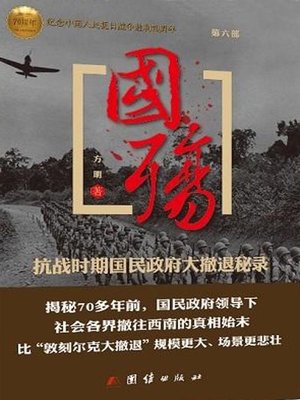国殇( Ode to the Fallen)
ebook ∣ 抗战时期国民政府大撤退秘录(第六部)(Secret Record on Retreat of Kuomintang Government in War of Resistance against Japanese Aggression Volume 6)
By 方明

Sign up to save your library
With an OverDrive account, you can save your favorite libraries for at-a-glance information about availability. Find out more about OverDrive accounts.
Find this title in Libby, the library reading app by OverDrive.



Search for a digital library with this title
Title found at these libraries:
| Library Name | Distance |
|---|---|
| Loading... |
史料记载撤退宜昌的情景: 原本是有10.5万人口的宜昌城已被滚滚而来的难民和源源不断运来的战时物资撑得爆满。这时在宜昌的难民至少有近10万人,其中包括8000名难童惶恐不安地在港口争抢着上船。人们都焦急盼望着能尽快让他们“换载”,而人多船少,很难如愿。为等购船票,往往一等就是半个月或一个月。从城区通惠路到船码头,大街小巷都是人,所有的旅店、客栈、学校都挤满了人,不少人只有露宿街头,栖身屋檐下。而此时天空中还不时有日军的飞机盘旋、轰炸…… 本书主要记述了抗日战争时期,面对日军强势的步步紧逼,国民政府及各行各界往大西南转移以备持久战的历史事件。书中有对撤退西南的原因与时机揭秘,有国民党撤往重庆前后的部署与撤退计划制定的内幕,还有工商界、文化界、文物及难民内迁时的经历详情。(Historical records of retreat to Yichang: Yichang, a city of 105 thousand people, was packed with refugees and wartime supplies that were constantly entering the city. The refugees in Yichang reached nearly 100 thousand, including 8,000 children anxiously waiting in the port to scramble aboard. People were looking forward to a ride as soon as possible, but it was hard with so few ships. It usually took half a month or a month to get a ticket. From Tonghui Road in the downtown to the pier, all streets were teeming with people, all hotels, inns and schools were full, and many people had to stay on the streets. What was worse, Japanese aircrafts were circling over the city, bombing...... This book mainly describes the historical event in which Kuomintang government and people from all walks of life retreated to Southwest China to prepare for a protracted war in the face of the strong Japanese military advancing step by step during the Anti-Japanese War period. The book reveals the reasons and opportunities for the retreat to Southwest China, the overall deployment of Kuomintang’s withdrawal to Chongqing, the insider information about the retreat plan as well as detailed migration experience of civilians from the business, culture and other circles as well as refugees and cultural relics.)







